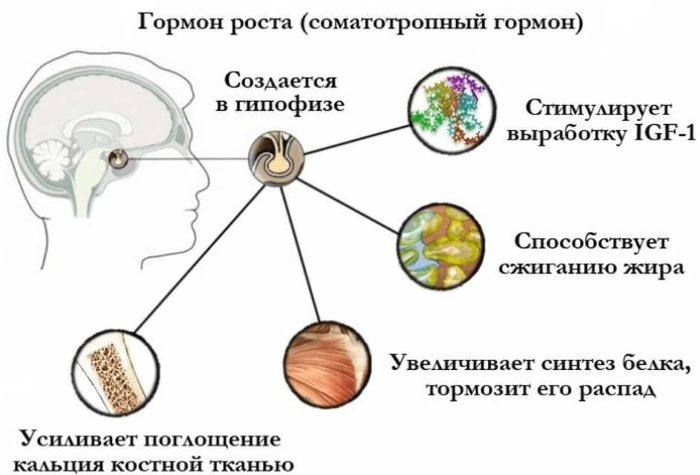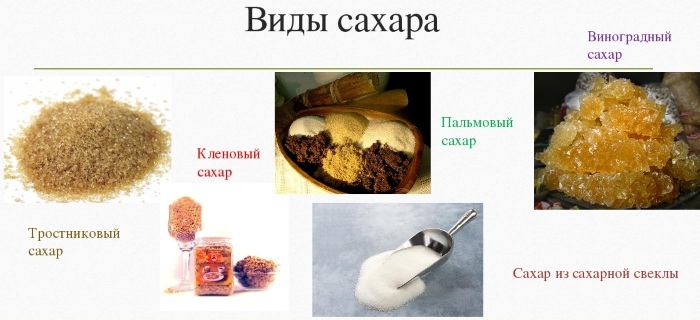Anesthesia or desensitization in part or body completely in surgery, gynecology and dentistry, they are constantly used in various kinds of operations. There are several types of anesthesia, which are selected depending on the health and characteristics of the patient, the type of operation and the desired effect.
Anesthesia blocks the perception of the patient's health, therefore any operation under anesthesia can have serious consequences, and the choice of anesthesia should be approached carefully and competently.
Record content:
-
1 Classification
- 1.1 Local
- 1.2 General
-
2 Top 10 drugs
- 2.1 Lidocaine
- 2.2 Novocaine
- 2.3 Ultracaine D-S
- 2.4 Brilocaine-adrenaline forte
- 2.5 Blockcos
- 2.6 Sevoran
- 2.7 Diethyl ether
- 2.8 Ketamine
- 2.9 Sombrevin
- 2.10 Propofol
- 3 Anesthesia video
Classification
Anesthesia in surgery, the types of which depend primarily on the type of operation, are subdivided depending on the type of impact on:
Local
Local anesthesia affects only a specific area of the body to varying degrees. Sometimes it is used to reduce the sensitivity of the skin, but more often to numb a specific area of the body.
Local anesthesia is divided into the following subtypes:
- terminal or surface anesthesia that blocks nerve endings and receptors. It is applied by lubricating or sprinkling the surface with special compounds. Most often, terminal anesthesia is used in otolaryngology, ophthalmology and dentistry;
- infiltration anesthesia cuts off sensitivity in receptors and small nerve endings and is injected into separate layers of tissue through a syringe. This method is actively used in dentistry or otolaryngology and the duration of this anesthesia is 10-15 minutes;
- anesthesia in surgery, the types of which include conduction anesthesia, affects the nerve trunks and plexuses. Conductive anesthesia is administered by injection into adjacent tissues. The duration of the action of anesthesia begins instantly and is about 45 minutes;
- plexus anesthesia is injected through a syringe into the nerve plexuses. Due to the delayed action, anesthesia relieves the sensitivity of an individual part of the body for 2-3 hours. and is most often used in operations on the upper limbs;
- epidural anesthesia works after the drug is injected into the epidural space of the spine with a syringe or through a catheter. Such anesthesia renders the lower body numb and is often used for caesarean section, uterus and lower extremity surgery;
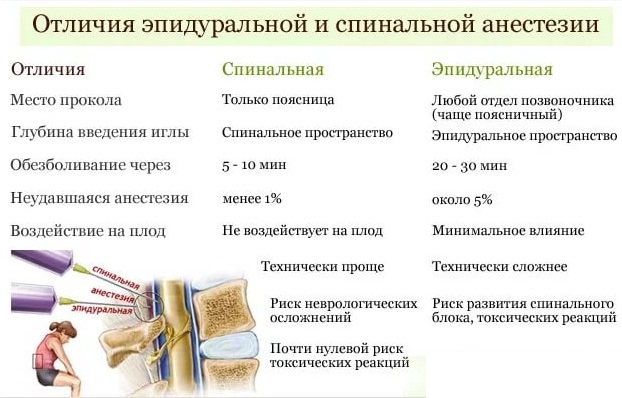
- spinal anesthesia acts through the blockade of the spinal roots by injecting a drug into the subdural space of the spine. Such anesthesia is more often used in operations on the abdominal region, during cesarean section and urological operations;
- caudal anesthesia also acts on large clots of nerve endings. It is introduced into the sacral spine through a catheter for surgical interventions in the lower abdomen and extremities, the perineal region;
- intraosseous anesthesia is used in operations on the lateral lower and upper itching in cases where other types of anesthesia have not given the desired effect. In this case, the anesthetic composition is injected directly into the bone until the desired effect is achieved.
General
Anesthesia in surgery, the types of which determine the method and drug for pain relief, is used for most surgical interventions in the form of general anesthesia.
General (regional) anesthesia places the patient in a controlled coma, in which sensation is reduced throughout the body. General anesthesia allows you to remove resistance and in some cases is the only possible way to provide pain relief during surgery (for example, in children).
There are several types of general anesthesia:
- inhalation or mask anesthesia, which uses inhalation anesthetics that are delivered directly into the airways. With this type of anesthesia, only gaseous preparations are used, which make it possible to make inhalation anesthesia fast and well controlled. When the supply of a gaseous drug is stopped, the patient quickly regains consciousness, which is very important if complications arise after the start of the operation;
- intravenous anesthesia is administered by injecting the drug into a vein. In this case, the patient is not agitated and falls asleep quickly. Anesthesia acts for a long time and is gradually eliminated from the body;
- combined anesthesia is more often used in adult patients when intravenous anesthesia is supplemented by inhalation. This combination is used for complex and lengthy operations and is completely safe for the patient;
- endotracheal anesthesia involves immersing the patient in a state of general anesthesia by injecting medication through a special tube in the trachea. This method frees up the airways and allows operations on the face and head.
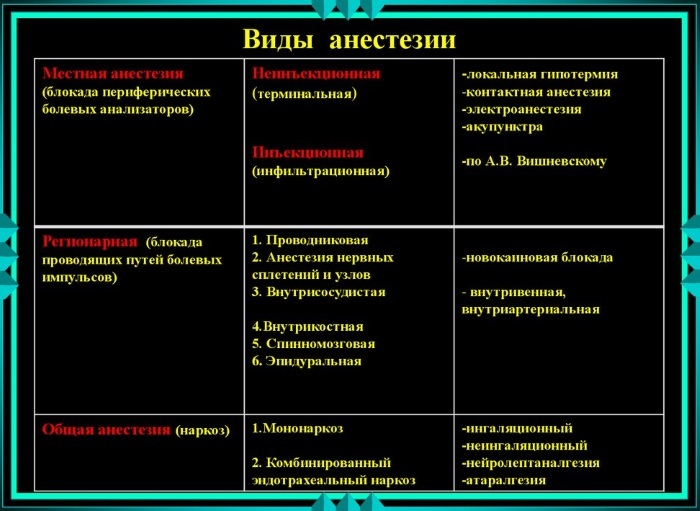
| Type of anesthesia | Subtype of anesthesia |
| local | terminal |
| conductor | |
| infiltrative | |
| plexus | |
| epidural | |
| spinal | |
| caudal | |
| intraosseous | |
| general | inhalation |
| intravenous | |
| combined | |
| endotracheal |
Top 10 drugs
Anesthesia in surgery, the types of which affect the effect achieved during anesthesia, is used for various purposes: from standard medical procedures to complex surgical interventions. Most often, the following are used as drugs for anesthesia:
Lidocaine
Lidocaine is used for general and regional anesthesia in operations of varying complexity. The medicine is suitable for injection, irrigation and lubrication of tissues during the procedure.

The drug consists of lidocaine hydrochloride, sodium chloride and water and is available in the form of ampoules. The dose of administration is determined by the anesthesiologist at the rate of 5-10 mg per 1 kg of body, but not more than 300 mg per day. The drug is not used for hypovolemia, III degree AV blockade and hypersensitivity to drug components.
When taking the drug, hypersensitivity, dizziness and blurred vision may occur in some patients. If the dose is exceeded, the patient experiences convulsions, tremors and a possible coma. All this is accompanied by impaired vision and breathing. The price of the drug starts from 50 rubles.
Novocaine
Novocaine contains procaine, hydrochloric acid and purified water.
The drug is available in ampoules for injection and is used for:
- intraosseous anesthesia;
- perirenal;
- cervical;
- paravertebral blockade.
In surgery, this type of drug has a local anesthetic effect by lowering the sensitivity of nerve endings, reduces excitability and eliminates smooth muscle spasms. The drug has no contraindications and is not used only for hypersensitivity to the active substance and operations in children under 12 liters.
Enter novocaine with infiltration anesthesia at 400-600 mg. with the subsequent possible increase in a single dosage to the maximum possible. When using novocaine, in rare cases, patients experience drowsiness, headache and an increase or decrease in blood pressure.
In case of an overdose, the patient develops pallor, irregular heartbeat and nausea. Packing price starts from 30 rubles.
Ultracaine D-S
Ultracaine D-S contains a combination of articaine hydrochloride and epinephrine, as well as water and sodium chloride. Anesthetic is produced in ampoules for infiltration and conduction anesthesia in dentistry.

The combined local anesthetic drug has a long-lasting analgesic effect. Ultracaine has a high tissue tolerance and has little effect on the cardiovascular system.
Due to its complex composition, the drug is contraindicated in:
- heart defects and heart failure;
- anemia;
- hypoxia;
- hypersensitivity to the components of the drug;
- hyperthyroidism;
- children under 4 years of age.
The drug is administered at 1-1.7 ml intravenously for each tooth during dental surgery and 7 ml per 1 kg of body during medical procedures.
Side effects of the drug are expressed by headache, nausea and a decrease in blood pressure. When the dose is exceeded, patients experience agitation, dizziness and respiratory distress. The cost of the medicine is 1250 rubles on average.
Brilocaine-adrenaline forte
Brilocaine-adrenaline forte consists of epinephrine and articaine and is a local anesthetic of a number of thiophenes. The drug is used for infiltration and conduction anesthesia, most often in dentistry. The medicine blocks the conduction of nerve impulses from neurons and helps to reduce blood vessels.
Contraindications for the drug include:
- tachycardia and arrhythmia;
- individual intolerance to the components of the drug;
- liver failure;
- asthma;
- diabetes;
- pregnancy;
- children up to 4 years old.

The drug is administered in 5-30 ml, depending on the type of anesthesia and 1.7 ml for each tooth during dental operations. When using the drug, in some cases, headache, diarrhea and tremors occur. In case of an overdose, dizziness, itching of the skin and impaired cardiovascular activity may appear. The price of the drug starts from 750 rubles.
Blockcos
Bupivacaine hydrochloride, sodium chloride and auxiliary components are part of blockcos ampoules. The drug has a strong local analgesic effect, completely blocking the conduction of a nerve impulse.
The medicine is used for operations of a different nature and in the postoperative period for pain relief. The medicine is not applicable only for children under 12 liters, with reduced blood clotting and hypersensitivity to the components of the drug. A single dose is calculated individually at 10-50 mg, depending on the type of anesthesia.
A side effect occasionally causes nausea, heart rhythm disturbances and numbness of the tongue in patients. An overdose of the drug can provoke skin allergies and anaphylactic shock. The cost of the drug starts from 1250 rubles.
Sevoran
Sevoran is widely used for inhalation anesthesia. The drug contains sevoflurane and is available as a liquid for inhalation. Sevoran quickly puts the patient into general anesthesia and allows a quick exit from anesthesia, therefore it is used for induction and general anesthesia in children and adults during surgical operations.
The drug is not used only for individual intolerance and during breastfeeding.
The drug is administered by inhalation at a concentration of 1.7-3% in oxygen in combination with dinitrogen oxide or without it.
In rare cases, nausea, coughing, and vomiting occur after sevoran anesthesia. In case of an overdose of the drug, the patient may experience cardiac and respiratory disorders. The cost of a bottle averages 8500 rubles.
Diethyl ether
Diethyl ether is 1,1-Oxy-bis-ethane, which is available in inhalation bottles. The volatile liquid dissolves well in water and is administered through the respiratory tract.
Diethyl ether blocks the central nervous system by suppressing the transmission of arousal. The drug allows the patient to be injected into deep anesthesia and lasts for 10 seconds. Ether is used for inhalation anesthesia during operations and for treating the surfaces of teeth and canals.
The drug is not recommended for use when:
- tuberculosis;
- respiratory tract diseases;
- increased intracranial pressure;
- cardiovascular disease and hypertension;
- diabetes mellitus, renal and hepatic failure.
Side effects when using the drug are expressed in the form of tachycardia, the appearance of minor nausea and cough. If the dose of the drug is exceeded, the drug can cause depression of the heart and respiratory center, asphyxia, which disappear when the supply of ether is stopped.
In the case of a semi-closed system, the drug is administered at 10-12% for deep anesthesia and maintenance of anesthesia. The price of packaging the drug is 680 rubles.
Ketamine
Ketamine is considered a proven drug for intravenous anesthesia. The drug contains the active ingredient ketamine in the form of hydrochloride, which causes dissociative anesthesia. The drug inhibits some areas of the brain and excites others, causing an analgesic effect.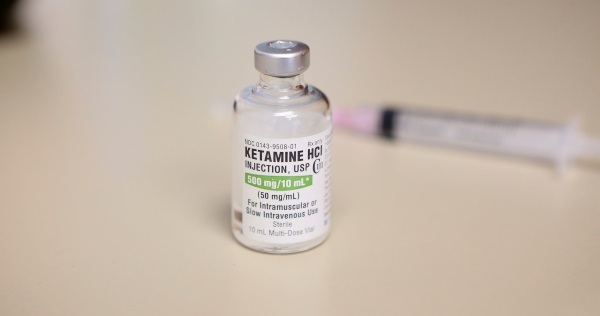
Ketamine is used for general anesthesia in various surgical procedures, including emergency cases. Contraindications for the drug include: heart attack, impaired head circulation and childhood. The drug is used intramuscularly at 4-8 mg / kg and intravenously at 2-3 mg / kg.
In rare cases, during anesthesia, the patient may experience shortness of breath, an abnormal heart rhythm, and local pain. If the prescribed dose is exceeded, the patient may experience respiratory and heart rhythm disturbances, and intraocular pressure may increase. The average cost of a package is 1200 rubles.
Sombrevin
Sombrevin in an ampoule contains propanidide up to 500 mg. The drug is used for long and short-term operations and in diagnostic procedures and has an anesthetic effect on the body.
Contraindications to the use of the medication include:
- tendency to seizures;
- cardiovascular diseases;
- liver and kidney disease;
- alcohol intoxication;
- shock states.
The average single dose of the drug is 500 mg, and to increase the time of anesthesia, sombrevin can be re-administered at a lower dosage (20-30% of the initial dose). The drug does not cause adverse reactions, with the exception of a slight increase in respiration rate. The cost of the medicine starts from 2,000 rubles.
Propofol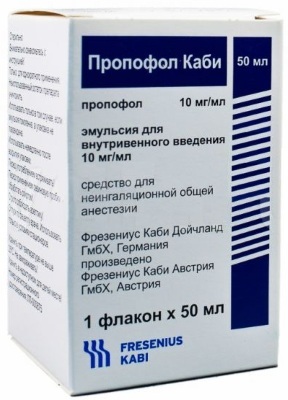
In surgery, propofol is often used for general anesthesia, which consists of the active substance - propofol and auxiliary components.
The drug is available in the form of an emulsion or powder for injection and acts on the neurons of the central nervous system, cutting off the neural channels.
Propofol is used for general anesthesia and sedation on EVL.
It is not prescribed for allergic reactions and for children under 16 liters. The drug is administered at 2-2.5 mg / kg intravenously for several minutes until signs of anesthesia appear, and then at a lower dose to maintain anesthesia.
As side effects of the drug, headache, convulsions and thrombosis are noted. In case of overdose, side effects may increase, causing cardiac abnormalities. The price of the drug is 540 rubles.
Anesthesia video
Seminar "Anesthesia and Surgery":

